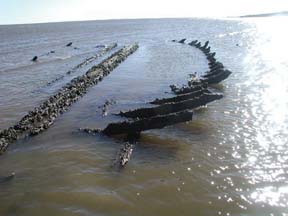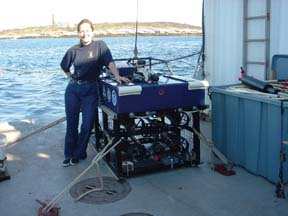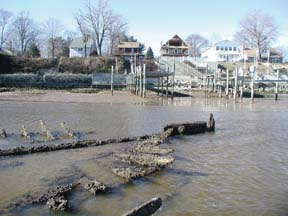Underwater Archaeology: History From the Deep
By Nancy Breslau Lewis

Many Annapolitans are aware that archaeological remains lie beneath Maryland’s modern urban landscapes and rolling hills. But few of us realize just how much archaeological bounty remains unexcavated in soggier parts of our state.
More than 550 known archaeological sites lie beneath the waters of the Chesapeake Bay, or buried under layers of silt on riverbanks, or in marshes, according to Susan Langley, PhD, Maryland’s State Underwater Archaeologist. In a day-long workshop held in late April at the Annapolis Maritime Museum as part of Goucher College’s Historic Preservation Certificate Program, Langley pointed out that “Maryland is 25 percent water, so we have a lot of turf to cover, so to speak.”
One of only nine state underwater archaeologists in the United States, Langley was educated and trained in Canada. She has worked in far-flung locations ranging from iceberg-filled waters of Labrador, where she explored a Basque whaling galleon that sank nearly 500 years ago, to Thailand, where she taught underwater archaeology for a branch of UNESCO.
 When she first accepted the position of Maryland’s State Underwater Archaeologist more than 11 years ago, only one percent of the state’s underwater archaeological sites had been explored. Under her watch, the state has allocated significant amounts of money for underwater archaeology and purchased sophisticated equipment, including marine magnetometers (which reveal the presence or absence of iron objects), side-scan sonar (which detects objects that project above a river or sea bottom) and Global Positioning Systems that enable divers and archaeologists to more precisely pinpoint the locations of intriguing underwater anomalies that appear to be man-made. By 2004, 34 percent of Maryland’s underwater sites had been investigated. While Langley modestly notes that “I was holding the tiller when that happened,” workshop attendees exposed to her encyclopedic knowledge of marine archaeology and adrenaline-fueled, rapid-fire delivery (“Let’s break for coffee—I just need the grounds, it cuts out the middle-man”) know better. Maryland’s submerged history, as represented by 12,000-year-old Native American artifacts, colonial-period quays, and ships sunk in skirmishes during the War of 1812, the Civil War and the two 20th-century World Wars, could not have a more fierce protector. When she first accepted the position of Maryland’s State Underwater Archaeologist more than 11 years ago, only one percent of the state’s underwater archaeological sites had been explored. Under her watch, the state has allocated significant amounts of money for underwater archaeology and purchased sophisticated equipment, including marine magnetometers (which reveal the presence or absence of iron objects), side-scan sonar (which detects objects that project above a river or sea bottom) and Global Positioning Systems that enable divers and archaeologists to more precisely pinpoint the locations of intriguing underwater anomalies that appear to be man-made. By 2004, 34 percent of Maryland’s underwater sites had been investigated. While Langley modestly notes that “I was holding the tiller when that happened,” workshop attendees exposed to her encyclopedic knowledge of marine archaeology and adrenaline-fueled, rapid-fire delivery (“Let’s break for coffee—I just need the grounds, it cuts out the middle-man”) know better. Maryland’s submerged history, as represented by 12,000-year-old Native American artifacts, colonial-period quays, and ships sunk in skirmishes during the War of 1812, the Civil War and the two 20th-century World Wars, could not have a more fierce protector.
The state’s buried ports, riverside wharves, canals and shipwrecks are continually threatened by forces both natural (violent weather, tides and erosion) and man-made (industrial pollution, encroaching development and looters). Once an underwater archaeological site has been pinpointed, Langley and her team work to stabilize the remains. They face formidable challenges. Underwater archaeological excavation is not only prohibitively expensive (the recent retrieval of the Hunley, a Civil War-era submarine, from the bottom of South Carolina’s Charleston Harbor cost $21 million); more frequently than not it destroys the integrity of a site.
So Maryland’s underwater archaeologists usually follow a standard strategy of preserving marine remains in-situ. They take photos, create maps, and make casts and models. “If you have only ten percent of a ship’s hull,” Langley noted, “you can reconstruct the ship. Construction techniques can tell us about the people who built the vessels, artifacts can tell us about the people who profited from the ship’s trade, and eco-facts—evidence of insect infestation and organic remains, such as seeds, that are preserved in anoerobic, muddy environments—can tell us about the climate and season when a ship sank.”
Langley makes it a point of honor to publish her finds as soon as possible. “We reconstruct the site on paper: If a report isn’t written, you’re no better than a treasure-hunter.” Her reports only make vague reference to the find-spot, however, to keep looters at bay.
 Although many wrecks lie beneath the Chesapeake and its numerous tributaries and inlets, spotting them in the murky water isn’t easy. As Langley explained, “There is no visibility in the Bay. It’s archaeology by braille. You hope that the thing that bumps into you down there is the guy you’re diving with.” And when the skeleton of a ship’s hull appears off the coast of Maryland’s Atlantic beaches, she makes no assumptions about where the vessel originally foundered. Currents can carry wooden remains to Maryland from as far away as Long Island Sound. Although many wrecks lie beneath the Chesapeake and its numerous tributaries and inlets, spotting them in the murky water isn’t easy. As Langley explained, “There is no visibility in the Bay. It’s archaeology by braille. You hope that the thing that bumps into you down there is the guy you’re diving with.” And when the skeleton of a ship’s hull appears off the coast of Maryland’s Atlantic beaches, she makes no assumptions about where the vessel originally foundered. Currents can carry wooden remains to Maryland from as far away as Long Island Sound.
Langley noted that shipwrecks are very dynamic processes. “A ship doesn’t simply wreck and that’s it. Stuff floats off, some items are salvaged, others disintegrate. Sea worms and crabs do their work. There’s movement in the sea bed, both preserving and destroying the site: Waves and currents can deposit protective sand over a wreck, shorelines shift. The land doesn’t stay still, even if a wreck does.”
Shifting shorelines bring other, more macabre remains to light, too. Not long ago, a weathered pine coffin washed ashore near Crisfield and Langley was notified (“If it’s in the water they tend to call us.”) From the skeletal and scant clothing remains inside the coffin, she eventually deduced that the coffin had originally been buried on Jane’s Island and had drifted towards Crisfield when the island’s shoreline eroded; that its occupant was an African-American male who made his living as an oyster tonger; and that he likely died during a 1918 smallpox epidemic.
But inorganic remains account for most of the underwater archaeologist’s discoveries. When the seawall at Ft. McHenry in Baltimore Harbor was slated to be repaired a few years ago, Langley was summoned. After all, the British navy had lobbed 1,500 shells and cannonballs at Fort McHenry during the War of 1812 and only 400 of them actually landed at the fort. It was Langley’s job to try and determine where the rest of all those “bombs bursting in air” had wound up, so workmen wouldn’t encounter any explosive surprises. When maintenance dredging in the harbor was done in 2003, more than 1,300 pieces of ordnance were recovered, including five live Schenkl and Hotchkiss shells, several canons, and a 325-lb. bomb dating from the Civil War.
Other water-saturated archaeological sites discovered in recent years include a large wharf found in tidal flats in Pemberton Hall, near Salisbury on the Eastern Shore. Using dendochronology, the science of determining the age of a wooden object by counting tree rings in lumber, Maryland marine archaeologists determined that the wharf was constructed in 1747 and was thus the earliest bulkhead wharf in the United States. Langley noted that the presence of docks like the one at Pemberton Hall often suggests that other artifacts are likely to be in the vicinity, since merchandise not infrequently fell into the water as it was transferred from ship to shore and vice-versa.
Maryland canals have also yielded archaeological gold. Four sets of well-preserved 19th-century lock gates were discovered buried in the mud near the terminus of the Susquehanna & Tidewater Canal in Havre de Grace. After being analyzed so that replicas could be made, the locks were reburied to best preserve them.
 Maryland’s underwater archaeologists have also examined middens, or dump sites, and uncovered evidence of long-vanished buildings, as well as artifacts. When disgruntled neighbors living in Dundalk reported that people were digging giant holes near the Bay, archaeologists discovered that the area was filled with old chamber pots and bottles. Further research determined that a 19th century mental hospital had been located nearby and the site was soon protected by signs reading “Artifact collection prohibited, both on land and in water.” Maryland’s underwater archaeologists have also examined middens, or dump sites, and uncovered evidence of long-vanished buildings, as well as artifacts. When disgruntled neighbors living in Dundalk reported that people were digging giant holes near the Bay, archaeologists discovered that the area was filled with old chamber pots and bottles. Further research determined that a 19th century mental hospital had been located nearby and the site was soon protected by signs reading “Artifact collection prohibited, both on land and in water.”
The job of reconstructing a long-forgotten, vanished shoreline, and its associated ships and port buildings, starts by following a paper trail. “Read first; do second,” Langley advises. Old maps, photos and postcards can provide important clues; deeds often indicate property lines and the locations of old structures. Present-day street names can steer archaeologists in the right direction, too: “Steamboat Lane” and “Old Ferry Point Road” almost certainly terminate in an area that once housed structures associated with river and bay shipping.
Though most underwater archaeological sites remain unnoticed by the general public, there are some notable exceptions. In 1994, Susan Langley’s program (a division of the Maryland Historical Trust), in conjunction with the U.S. Navy, created the first Historic Shipwreck Preserve in Maryland. The site contains the remains of The Black Panther, a German U-boat (U-1105) captured during the Second World War and later used by the Navy for demolition testing. The U-boat was eventually scuttled in 90-foot waters off the coast of Piney Point, Maryland. Today a mooring buoy marks the location of this shipwreck preserve, which is accessible to experienced civilian divers.
Langley is now advocating for the establishment of a second underwater preserve in the state. The shallow waters of Mallows Bay, 30 miles south of Washington, D.C. along the Potomac River, contain the hulking ruins of 150 First World War-vintage ships. “The site has so much potential for low-impact recreation and kayaking,” she noted. At the close of the workshop, Maryland’s State Underwater Archaeologist looked into the eyes of the attendees and succinctly summed up her mission: “The past continues to speak to us. Let’s listen.”
Back |

